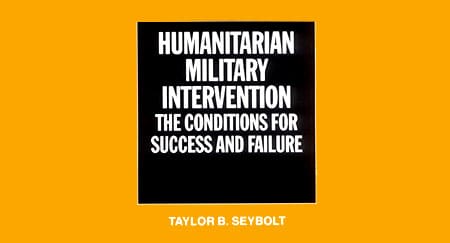Matthew Taylor reviews "Humanitarian military intervention: The conditions for success and failure" by Taylor B. Seybolt
The mythical detective Sherlock Holmes once solved a case by working on what didn't happen. Silver Blaze, a race horse, had been stolen. But the night it happened, the stable dog had not barked. Holmes calculated that 'the missing bark' meant that the dog had recognised the thief.
Taylor B. Seybolt uses silent voices to investigate Humanitarian Military Interventions. His study focuses on limited incursions, with specific short term objectives, such as halting genocide and feeding the starving. United Nations operations in Somalia throughout the 1990s fit, the Iraq war of 2003 does not.
The study aims to influence policymakers in strong states contemplating armed protection of civilians in weak ones. Seybolt provides thorough analysis of operations in northern Iraq (1991), Somalia, Bosnia and Herzegovina, Rwanda, Kosovo and East Timor to support his arguments.
He attempts to pull the lofty, 'just war' principle of 'having a reasonable prospect of success' down to the unpredictable realities of anarchic crisis areas. He offers a checklist for leaders that is securely linked to the myriad of practical factors on the ground. In the first instance, a reasonable prospect of success means the likelihood of saving lives.
As Holmes used missing evidence to solve real murders, Seybolt uses missing murders as evidence to measure success. To provide lessons for the future, he focuses on the victims that did not perish thanks to foreign interventions.
Perhaps predictably, this argument shows signs of unravelling. Measuring what might have been will never be an exact science. He acknowledges the wide error-margins in this approach, and through logic and logical analysis, succeeds in providing ballpark figures on numbers of people saved.
One of the most compelling parts of the book are the case studies, which offer considerations that may help save lives through intervention. Discussions on the effectiveness of 'safe zones' in war-torn Bosnia and Herzegovina and the reactive timidity of interveners in Somalia are particularly interesting.
More attention could be paid to motives of local actors, yet these case studies offer some logical advice. It essentially boils down to the following points:
- Move in swiftly;
- address the problem;
- do not underestimate local resistance, they may have more at stake,
- using overwhelming force, where necessary, may ultimately save lives;
- going in with overwhelming force may mean you won't need to use it;
- ensure effective communication with friends and partners at all levels; and,
- respond to violence proportionately.
Seybolt is not a soldier, and his forays into tactical analysis are less applicable than the core strategic points. Brief discussions of convoy and compound defence tactics are cases in point.
Seybolt rejects the majority of abstract, philosphical literature on the subject, to focus on real problems, faced by real practitioners both in theatre and in the halls of power. Military intervention in the name of humanity will remain a central policy challenge in the near future, and Seybolt's work succeeds in providing valuable new insights for practitioners at both ends of the spectrum.
Yet his guidelines are largely common sense based. Interesting case studies are well researched and a pleasure to read. But these are bright sparks in an otherwise long and ponderous justification of simple, yet practical ideas.
Like Holmes, Seybolt methodically details his case, but Holmes solved murders quickly.

